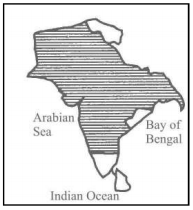
(a) Kanishka at the time of his death.
(b) Samudragupta after the close of his South Indiancampaign.
(c) Ashoka towards close of his reign.
(d) Empire of Thaneswar on the eve of Harsha’s accession.

(a) Kanishka at the time of his death.
(b) Samudragupta after the close of his South Indiancampaign.
(c) Ashoka towards close of his reign.
(d) Empire of Thaneswar on the eve of Harsha’s accession.
(a) Dipavamsa
(b) Divyavadana
(c) Mahaparinibban
(d) Dharma Chakara Pravartana Sutta
(a) Sohgaura Copper-plate
(b) Rummindei Pillar-edict of Ashoka
(c) Prayaga-prasasti
(d) Mehrauli Pillar inscription of Chandra
1. Lothal : Ancient dockyard
2. Sarnath : First Sermon of Buddha
3. Rajgir : Lion capital of Ashoka
4. Nalanda : Great seat of Buddhist learning
Select the correct answer using the codes given below:
Codes:
(a) 1, 2, 3 and 4
(b) 3 and 4
(c) 1, 2 and 4
(d) 1 and 2
Assertion (A): According to Ashoka’s edicts social harmony among the people was more important than religious devotion.
Reason (R): He spread ideas of equity instead of promotion of religion.
(a) Both A and R are true but R is the correct explanation of A
(b) Both A and R are true but R is not a correct explanation of A
(c) A is true but R is false
(d) A is false but R is true
1. Gold coins
2. Punch marked silver coins
3. Iron plough
4. Urban culture
Select the correct answer using the codes given below:
(a) 3, 4, 1, 2
(b) 3, 4, 2, 1
(c) 4, 3, 1, 2
(d) 4, 3, 2, 1
1. Mrichchakatikam–Shudraka
2. Buddhacharita–Vasuvandhu
3. Mudrarakshasha–Vishakadatta
4. Harshacharita–Banabhatta
Select the correct answer using the codes given below:
Codes:
(a) 1, 2, 3 and 4
(b) 1, 3 and 4
(c) 1 and 4
(d) 2 and 3
(a) I and X
(b) I and XI
(c) II and XIII
(d) II and XIV
(a) Buddhism was in the ascendant at that time
(b) they had renounced the policy of war and violence
(c) caste-ridden Hinduism did not attract them
(d) Buddhism provided easier access to Indian society